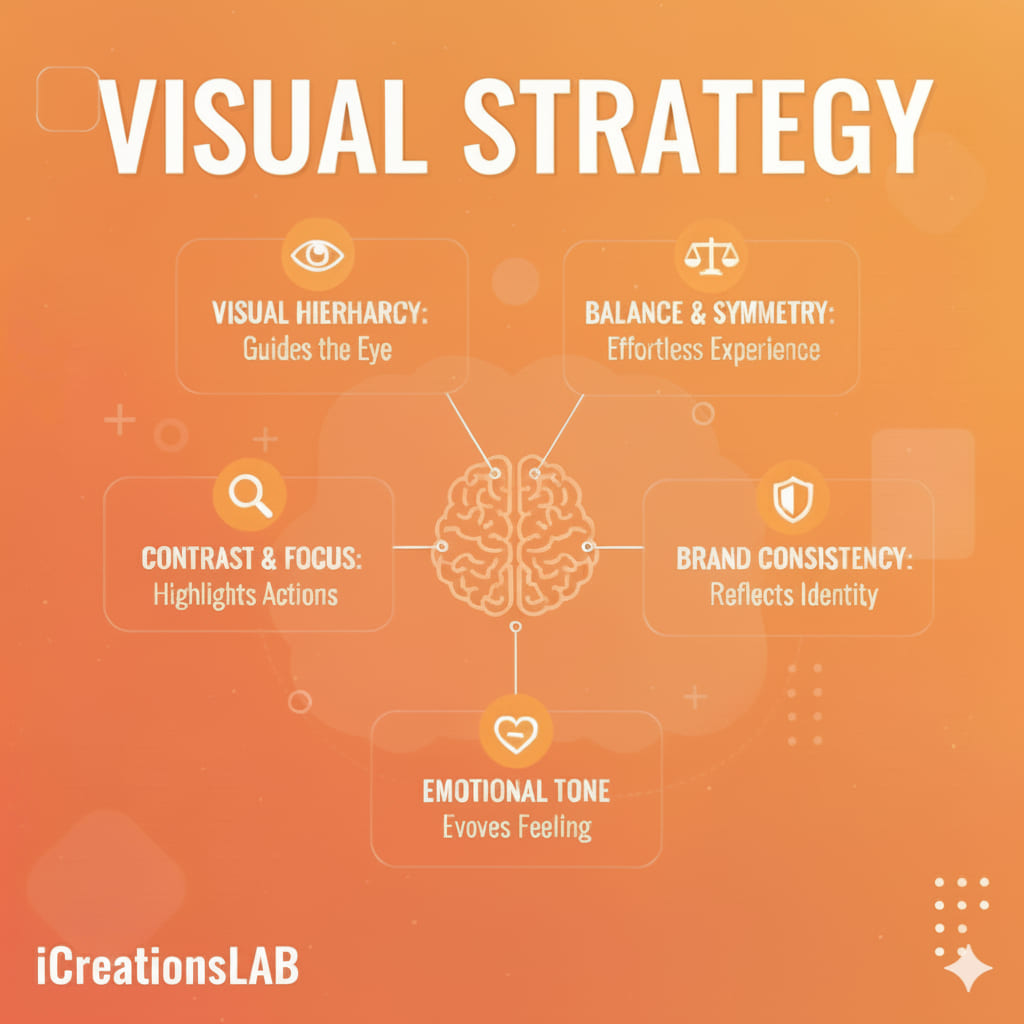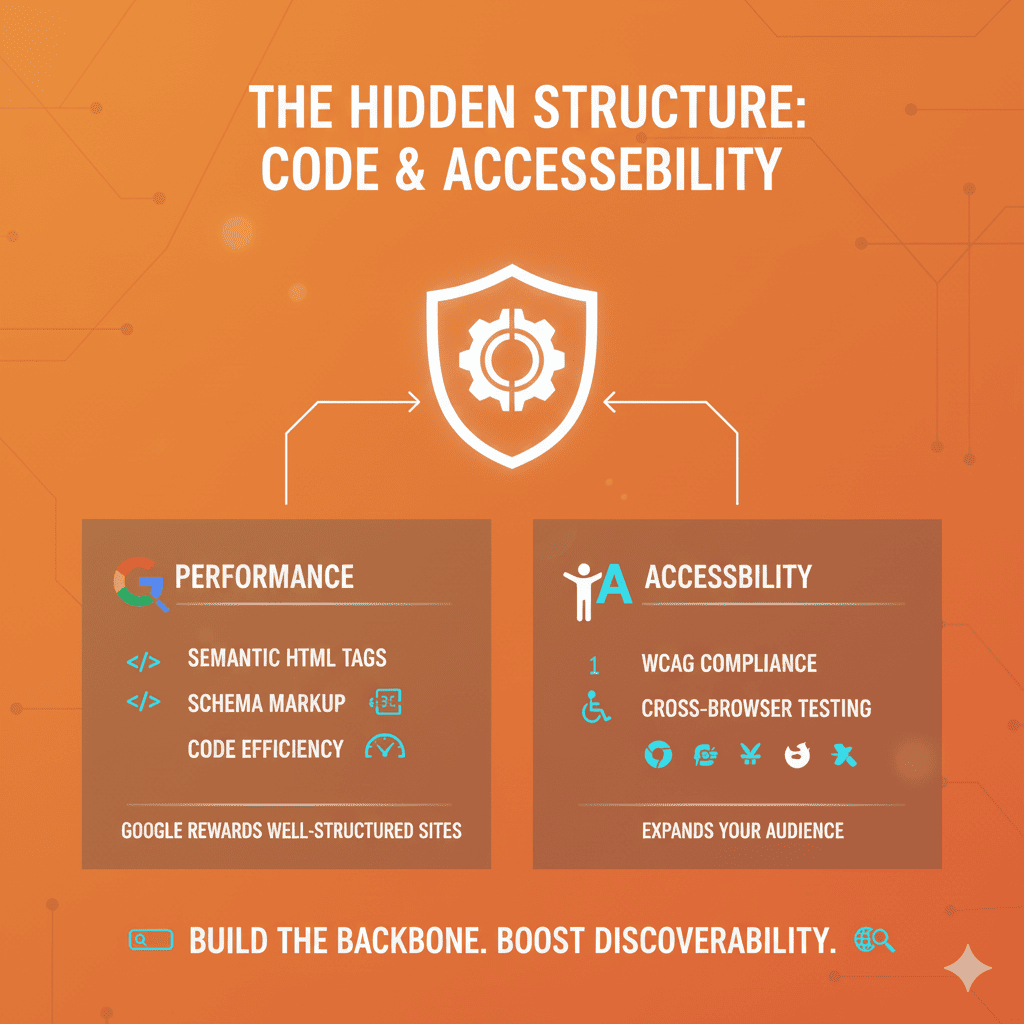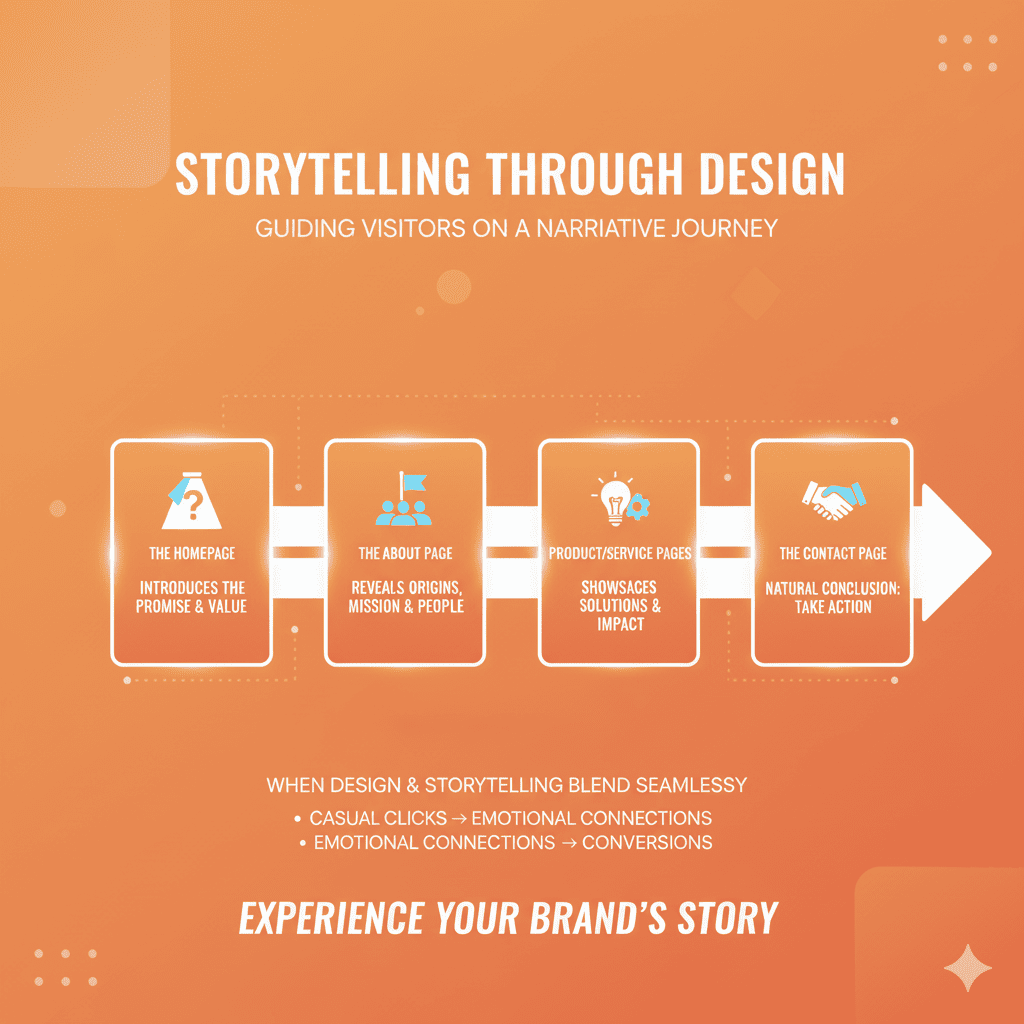When “Looks Good” Isn’t Good Enough
Most business owners judge their website by how it looks.
If it’s clean, modern, and uses your brand colors — you might think it’s “good enough.”
But ask a professional web design company, and they’ll show you a completely different picture.
They see beyond aesthetics — into the technical structure, user journey, search visibility, and conversion mechanics that make or break a website’s success.
Let’s dive into how top web design companies evaluate a site, what they see that most people don’t, and how you can use that insight to improve your own website performance.
1. Visual Appeal vs. Visual Strategy

Most business owners look at visuals — the color palette, the hero image, or whether their logo “pops.”
But professional designers go deeper. A top web design company evaluates visual strategy — the science of how design elements guide attention, emotion, and decision-making.
What Professionals Look For
- Visual Hierarchy: The order in which the eye perceives information. Are headlines large and easy to read? Are call-to-action buttons clearly visible without competing with other elements?
- Balance and Symmetry: An asymmetrical layout might look creative but can confuse the eye. Designers balance whitespace, text, and images to make the experience effortless.
- Contrast and Focus: High contrast draws attention to important elements like pricing, forms, or offers. Too little contrast and your CTAs disappear; too much, and the design feels aggressive.
- Brand Consistency: Fonts, color tones, and imagery should reflect brand identity. A luxury brand, for instance, leans toward elegant fonts and neutral tones; a youth-oriented startup might favor vibrant color gradients.
- Emotional Tone: Design evokes emotion. Warm colors create energy; cool tones build trust. Even micro-elements like button shapes can change perception — rounded edges feel friendly, sharp edges feel decisive.
The Takeaway
A professional website doesn’t just look good — it guides the visitor’s eyes and emotions strategically. Every color, margin, and photo is chosen to influence user behavior toward the ultimate goal: engagement or conversion.
See More: Why Website Speed Matters for Google Ranking
2. First Impressions: Measured in Seconds
You have less than one second to make a first impression online.
In that 0.05 seconds, users decide whether your site feels trustworthy, credible, and relevant.
A top web design company focuses intensely on the “above-the-fold” zone — what users see before scrolling. It’s the digital equivalent of a shopfront display.
Key Elements of a Winning First Impression
- Clarity of Purpose: The site should instantly answer, “Who are you and what do you do?” A concise headline with supporting visuals can make or break user retention.
- Strong Visual Hook: Hero images or short looping videos (e.g., showing your product in action) capture attention faster than text.
- Unique Value Proposition (UVP): Within the first scroll, users must understand why your brand is different. The best websites highlight this in a single sentence.
- Primary Action Point: Whether it’s “Get a Free Quote” or “Start Shopping,” a clear CTA above the fold directs users where to go next.
- Minimal Distractions: Too many animations, banners, or autoplay videos dilute your message. Simplicity keeps focus on what matters.
Real-World Example
When Slack redesigned its homepage, they reduced text by 30% and increased their CTA visibility — resulting in a 27% higher conversion rate.
That’s the power of a 3-second clarity test.
If visitors can’t tell what your business offers within three seconds, you’ve already lost them — no matter how stunning your site looks.
See More: How to Register a Domain Name in Singapore (2025 Guide)
3. Design for Humans, Not for Owners
A common pitfall among businesses is designing for personal taste instead of user needs.
Many websites reflect what the founder likes, not what the audience wants to experience.
Top web design companies invert this approach — they use UX research and behavioral data to design around the human journey.
User-Centered Design Principles
- Empathy First: Before sketching a layout, professionals study the user. What are their pain points? What problems do they want solved?
- User Personas: Designers create fictional but data-based characters representing typical users (e.g., “Busy Professional Ben” or “First-Time Shopper Sally”).
- Heatmaps and Analytics: Using tools like Hotjar or Microsoft Clarity, they see where users click, how far they scroll, and where they drop off.
- Accessibility: A user-centered design also means inclusive design — ensuring text readability, color contrast, and easy navigation for all users, including those with disabilities.
Business Impact
When Airbnb shifted from an internal design focus to a user-centric one, conversion rates increased dramatically, and bounce rates dropped.
They realized that good design speaks the customer’s language, not the company’s ego.
Professional designers translate user data into design decisions — ensuring every pixel serves a purpose and every element drives an action.
4. The Hidden Structure: Code and Accessibility

To most users, a website’s code is invisible — but for a web design company, it’s the backbone of performance and discoverability.
A beautiful site built on poor code is like a luxury car with a broken engine.
Professional developers analyze your site’s underlying structure to ensure it’s efficient, accessible, and optimized for both Google bots and human users.
Key Areas Experts Evaluate
- Semantic HTML Tags: Elements like <header>, <article>, and <nav> help search engines understand content hierarchy. This improves SEO and accessibility.
- WCAG Compliance: Following Web Content Accessibility Guidelines ensures your site can be used by people with visual or mobility impairments.
- Schema Markup: Structured data added to code (like product reviews, prices, or FAQs) helps Google display rich results and boosts AI visibility.
- Code Efficiency: Minifying CSS/JS, removing redundant scripts, and lazy-loading images improve load speed dramatically.
- Cross-Browser Testing: Professionals test your site on Chrome, Safari, Edge, and mobile browsers to ensure consistent rendering.
Why It Matters
- Google rewards well-structured sites with better indexing.
- Accessibility expands your potential audience by up to 15%.
- Clean code makes future updates faster and less costly.
A strong code base isn’t something users notice — but it determines how search engines, accessibility tools, and algorithms interpret your website.
See More: 7 Common Web Page Design Mistakes That Drive Visitors Away
5. Mobile Experience and Thumb-Friendly Design
In Singapore and globally, over 70% of all website traffic comes from mobile users.
Yet, many businesses still rely on “shrink-to-fit” designs that simply compress desktop versions — leading to awkward navigation and slow performance.
A leading web design company takes a mobile-first approach — designing the small-screen experience before scaling up to desktop.
How Pros Build for Mobile
- Responsive Layouts: Fluid grids and flexible images adjust automatically to different screen sizes without breaking design proportions.
- Tap Target Optimization: Buttons are sized at least 48×48 pixels for easy tapping, spaced well apart to prevent accidental clicks.
- Readable Typography: Font sizes scale dynamically for small screens, ensuring no zooming required.
- Touch Navigation: Menus convert into collapsible “hamburgers,” while key actions (e.g., “Call Now,” “Add to Cart”) are placed within thumb reach.
- Performance Optimization: Professionals compress images, preload critical assets, and test speed using mobile data simulations (3G/4G).
Mobile-First Advantage
A Google study shows that mobile-friendly websites experience up to 67% higher conversion rates compared to non-optimized ones.
Moreover, Google’s Mobile-First Indexing means the mobile version of your site is what Google primarily uses to rank you.
A truly responsive design doesn’t just fit smaller screens — it feels effortless and natural for touch interaction.
6. Speed and Performance Metrics — The Hidden Power Behind Every Great Website
Most business owners look at a website’s design aesthetics — colors, layout, or animation.
But professionals see something else: technical weight and efficiency.
In the eyes of a web design expert, a website that “looks amazing” might actually be slowing your business down.
Why Speed Matters
Website speed isn’t just a convenience — it directly affects:
- User satisfaction: People expect a page to load in under 3 seconds.
- Search visibility: Google includes Core Web Vitals in its ranking algorithm.
- Conversion rates: Research shows that a 1-second delay can reduce conversions by 7%.
How Professionals Evaluate Performance
Top web design companies use advanced diagnostic tools like Google PageSpeed Insights, Lighthouse, and GTmetrix to identify performance bottlenecks. They analyze:
- Core Web Vitals (CWV):
- LCP (Largest Contentful Paint): How long it takes for the main content to appear.
- FID (First Input Delay): How quickly users can interact with the page.
- CLS (Cumulative Layout Shift): How stable the visual layout remains during loading.
- Server Response & CDN Efficiency:
They ensure hosting servers respond quickly and use Content Delivery Networks (CDNs) to deliver content globally with minimal latency. - Image Optimization:
Large, uncompressed images are a common culprit. Professionals apply lazy loading, WebP formats, and automated compression to maintain visual quality without slowing speed. - Code Efficiency:
They minify CSS and JavaScript, remove unused scripts, and implement asynchronous loading for smooth performance.
The Professional Mindset
A top web design company knows that speed isn’t just a technical metric — it’s a business differentiator.
Faster websites retain more visitors, reduce bounce rates, and outperform competitors in SEO and conversions.
See More: 10 Best Website Design & Development Companies 2025
7. Conversion-Centric Design — Every Pixel Should Drive Action
![]()
While most people admire a website’s looks, professional designers ask one question:
“Does it convert?”
A web design company doesn’t see a website as art — they see it as a sales engine.
Every layout, color, and button must move the visitor closer to taking action.
The Psychology Behind Conversion Design
A conversion-optimized website is built around user behavior and decision psychology. Designers consider:
- Visual Flow: Guiding the eye from headline → benefit → CTA (Call-to-Action).
- Trust Triggers: Using real testimonials, logos, or social proof to reduce hesitation.
- Emotional Design: Colors and visuals that evoke confidence, excitement, or urgency.
- Cognitive Ease: Minimal distractions, short forms, and clean layout reduce mental friction.
Key Conversion Principles Top Agencies Apply
- Strategic CTA Placement:
Buttons like “Get a Quote” or “Start Free Trial” are positioned where intent is highest. - Frictionless Forms:
Every unnecessary field increases drop-off. Top agencies test variations to find the sweet spot. - Mobile-First Conversions:
CTAs and forms are optimized for thumb reach and fast input on mobile devices. - Continuous A/B Testing:
Real data determines what headline, color, or layout performs best — not guesswork.
A well-designed site feels natural to navigate. Visitors instinctively know what to do next.
That’s not luck — that’s conversion architecture.
8. SEO Integration from the Start — Building Websites That Rank Naturally
SEO isn’t something you “add later.”
For professional agencies, SEO and web design are built together — like structure and skin.
When a site is designed without SEO in mind, it often ends up looking great but ranking poorly.
That’s why top web design companies integrate technical SEO and on-page optimization during development.
What SEO-Driven Design Includes
- Logical Heading Hierarchy:
Properly structured headings (H1 → H2 → H3) make pages easier for both users and search engines to interpret. - Semantic HTML Tags:
Using <header>, <main>, <article>, <nav> improves crawlability and accessibility. - Optimized URLs:
Clean, keyword-rich URLs (e.g., /web-design-company-singapore/) improve clarity and ranking. - Metadata and Schema:
Proper meta titles, descriptions, and structured data help Google display rich snippets. - Internal Linking & Navigation:
Smart linking guides both users and crawlers through your site efficiently. - Optimized Media:
Every image includes alt text, descriptive filenames, and correct sizing for SEO and accessibility.
Why It Matters
Search engines now prioritize user experience metrics (UX + technical SEO).
A website designed with SEO at its core achieves higher visibility, lower bounce rates, and stronger organic growth.
See More: Best Website Builders Compared: Which One Fits Your Business?
9. Content Strategy and Readability — The Words That Convert
A common mistake: businesses focus on visuals first and treat text as filler.
But in reality, content is the voice of your brand — and it’s what drives user action.
Professional web design companies understand that good design amplifies good content, not replaces it.
That’s why they work with content strategists and UX writers to craft messages that persuade, educate, and inspire.
Elements of a Strong Content Strategy
- Readability:
Content is formatted for scanning — short paragraphs, bold highlights, and visual breaks. - Emotional Resonance:
Copy speaks to pain points, ambitions, and emotions — not just features. - Tone of Voice:
Whether formal, friendly, or aspirational, tone consistency builds trust. - SEO Integration:
Keywords are placed naturally in headings and text without compromising readability. - Supportive Visuals:
Images, infographics, and videos reinforce key points to enhance comprehension.
Why Content Matters More Than Ever
In an era of AI-driven search (Google SGE, Gemini, and ChatGPT integrations), context and clarity are everything.
A site with clear, educational content is easier for AI to index, summarize, and recommend.
Beautiful design grabs attention — but powerful content keeps attention and converts it into results.
10. Data Analytics and User Behavior Tracking — The Science of Continuous Improvement
Launching a website is not the end of the process — it’s the beginning of optimization.
Professional web design companies don’t just deliver a product; they deliver a performance system.
How Data Drives Design Decisions
Once live, analytics tools provide insights into real user behavior:
- Google Analytics 4 (GA4):
Tracks sessions, sources, and conversions with advanced event tracking. - Hotjar & Microsoft Clarity:
Offer heatmaps, scroll depth, and session recordings to visualize engagement. - Conversion Funnels:
Identify where users drop off and what pages convert best. - A/B Testing Results:
Reveal which headlines, layouts, or CTAs perform better statistically.
From Data to Action
Top agencies regularly review these insights to:
- Improve navigation flow
- Adjust CTA placements
- Simplify checkout or contact processes
- Enhance mobile UX based on real-world behavior
Why It Matters
Without analytics, design decisions are just opinions.
With data, every change is measurable, testable, and improvable.
Professional web design is a cycle of design, measure, and refine — ensuring your website evolves as user expectations and search algorithms change.
See More: Custom UI UX Design Solutions for Businesses in 2025
11. Security and Maintenance Matter More Than You Think
When most business owners think about websites, they focus on design, speed, or SEO. Yet one of the most critical — and often ignored — aspects is security. A website can look great and load fast, but if it’s vulnerable to attacks or goes offline frequently, it can destroy trust in your brand overnight.
A professional web design company never treats security as an afterthought. Instead, it builds protection and maintenance into the very foundation of the site.
They ensure:
- SSL certificates are installed across all pages, ensuring every piece of data transferred is encrypted.
- Secure hosting that includes firewalls, DDoS protection, and daily automated backups.
- Regular CMS and plugin updates to patch vulnerabilities before hackers exploit them.
- Malware monitoring and recovery plans to ensure quick restoration in case of breaches.
- User access management, ensuring only authorized individuals can access backend systems.
A website that crashes, is hacked, or goes offline even once a week can cause massive reputational and financial damage. Consistency builds trust, and trust is the foundation of all online success.
12. The Psychology Behind Design Decisions

Effective web design goes far beyond colors, images, and layouts. Behind every pixel and placement lies psychology — the science of how users think, feel, and behave. Top web design companies use psychological insights to guide user attention and influence decision-making.
Here’s how professionals apply design psychology:
- F-pattern and Z-pattern reading behaviors: Understanding how users naturally scan web pages helps designers position key messages, CTAs, and visuals where attention is highest.
- Color psychology: Each color evokes emotion — blue builds trust, red creates urgency, green represents growth, and black signals sophistication.
- Gestalt principles: Grouping and spacing elements strategically helps users process information faster and more intuitively.
- Social proof and trust cues: Testimonials, client logos, certifications, and badges reassure visitors that your brand is credible and trustworthy.
Professional designers don’t guess what looks good — they design for how humans see, feel, and act. In essence, great design is visual persuasion.
13. Storytelling Through Design
The most successful websites don’t just display information — they tell a story. Every page, image, and word should guide visitors through a meaningful narrative that reflects your brand’s journey and purpose.
Top web design companies structure sites like a compelling story:
- The homepage introduces the big picture — your brand’s promise and value proposition.
- The About page reveals your origins, mission, and people behind the company.
- Product or service pages showcase how you solve real problems and create impact.
- The contact page becomes the natural conclusion — the user’s opportunity to take action and become part of your story.
When design and storytelling blend seamlessly, visitors don’t just browse your website — they experience it. Storytelling turns casual clicks into emotional connections, and those connections drive conversions.
See More: How Custom Web Development Services Can Skyrocket Your Sales
14. Integration with the Digital Marketing Ecosystem
In today’s digital landscape, your website should not operate in isolation. It’s the central hub of your entire online ecosystem, connecting seamlessly with your marketing, sales, and analytics platforms.
Top web design companies design and develop websites that integrate smoothly with key digital tools and technologies. This includes:
- Marketing and advertising tools like Google Ads tags, Meta Pixel, and retargeting scripts.
- CRM systems such as HubSpot, Salesforce, or Zoho for automated lead capture and tracking.
- Email marketing platforms like Mailchimp, Klaviyo, or ActiveCampaign for nurturing campaigns.
- Social media integration for easy content sharing and engagement tracking.
- Analytics and reporting dashboards that unify website and marketing performance in one view.
When all these systems talk to each other, your website becomes more than a digital brochure — it becomes an engine for marketing automation, customer insights, and long-term growth.
15. Continuous Optimization and Growth
A professional web design company never views a website as a one-time project. Instead, it treats it as a living, evolving asset that should continuously improve based on user data and market trends.
Ongoing optimization efforts typically include:
- A/B testing to compare versions of pages or CTAs and discover what drives higher engagement or conversions.
- Performance audits to track Core Web Vitals, accessibility, and load times regularly.
- Content updates and refreshes to ensure messaging stays relevant, keyword rankings remain strong, and information reflects current business offerings.
- UX enhancements driven by feedback and analytics, ensuring users always have the best possible experience.
The internet changes daily, and so should your website. The best digital agencies know that small, data-driven improvements made consistently over time yield massive long-term results.
Summary: What Top Web Design Companies See That You Might Miss
| Category | What Most People See | What a Top Web Design Company Sees |
| Design | Colors, layout, and logo | Visual hierarchy, conversion flow, and emotional triggers |
| Content | Text and visuals | Message clarity, tone consistency, and storytelling impact |
| Performance | It looks fine and loads okay | Core Web Vitals, code optimization, and server efficiency |
| SEO | Keywords and meta tags | Site structure, crawlability, and on-page schema |
| UX | It looks user-friendly | Data-backed interaction mapping and behavior analytics |
| Maintenance | Occasional updates | Continuous security, monitoring, and automated backups |
| Conversion | CTA buttons and forms | Behavioral triggers, funnel stages, and trust elements |
A professional web design company doesn’t just see what’s visible — it sees the invisible systems that turn design into measurable business outcomes.
See More: Professional Custom Web Development Services for Businesses in 2025
Seeing Your Website Through Expert Eyes
Your website might look good — but is it performing as well as it could?
An expert web design company doesn’t just focus on aesthetics. It analyzes, optimizes, and transforms your website into a high-performing digital asset that attracts visitors, engages them deeply, and drives real conversions.
When you see your website through expert eyes, you discover opportunities for growth that you didn’t know existed. The difference between a “nice-looking” website and a strategically designed one can mean the difference between online stagnation and digital success.
About iCreationsLAB
Founded in 2008, iCreationsLAB is a trusted web design company in Singapore dedicated to helping businesses transform their online presence. We combine design creativity, technical precision, and marketing strategy to deliver websites that perform, not just look good.
Our services include:
- Corporate Website Design
- E-Commerce Development
- Custom CMS Solutions
- SEO & Online Marketing Integration
With over a decade of experience, our team of designers, developers, and digital strategists has helped countless Singapore businesses grow their digital footprint.
Visit iCreationsLAB.com to discover how we can help you design, optimize, and elevate your website into a true growth engine for your business.

